Video
Daoism in the Tang (618–906) and Song (960–1279) Dynasties

Taoist ceremonial robe
Introduction to Daoism
Daoism is an indigenous Chinese religion. Dao is often translated as “way” or “path.” The teachings of Daoism advocate following the “way” and integrating with the natural world. Its legendary founder was Laozi, who lived in the sixth century B.C.E. However, most scholars believed that the real history of Daoism is rooted in indigenous religion of the second century and that it developed rapidly along with the advancement of Buddhism. Daoism developed its own unique meditation techniques. Daoists also had a particular interest in the pursuit of immortality and alchemy. As in the West, experiments in these pursuits led to unanticipated advances in chemistry and physics.
Chinese symbols and concepts commonly encountered in the West associated with Daoism are yin and yang, representing the balance of opposites and the concept of qi as a natural energy running through all existence. The popularity and familiarity of philosophical Daoism in the West in recent decades can even be observed in the plot device of “the force” in the film Star Wars.
Daoism in the Tang Dynasty
During the Tang Dynasty (618–906), Daoism enjoyed special patronage. Because Laozi’s surname is Li, identical to that of the Tang ruling house, the emperors revered Laozi as one of their ancestors and supported he development of Daoism. This support included building Daoist temples and establishing schools to enroll students studying Daoist canons. Under the patronage of the emperors, Daoism flourished in the Tang. Nonetheless, Daoism had to compete with Buddhism for converts. Such competition is reflected in a passage written by Han Yu entitled The Girl of Mt. Hua. It relates how a female Daoist priest, in rivalry with Buddhists, used her charm and eloquence to attract an audience:
In streets east, streets west, they expound the Buddhist canon, clanging bells, sounding conches, till the din invades the palace. The girl of Mount Hua, child of a Daoist home, longed to expel the foreign faith, win men back to the Immortals; she washed off her powder, wiped her face, put on cap and shawl. With white throat, crimson cheeks, long eyebrows of gray, she came at last to ascend the chair, unfolding the secrets of Truth.
(Translated by Burton Watson, from the Columbia Book of Chinese Poetry)
From this text, we learned that monks customarily traveled far and wide to preach their doctrines, causing unease among Daoists. In this instance, a female Daoist engaged herself among the field of proselytizers and won over the monks. However, generally speaking, during the Tang dynasty Buddhism was more influential than Daoism. In the waning years of the Tang, Daoism experienced a setback.
Daoism in the Song Dynasty
However, in the Song (960–1279) dynasty, Daoism recovered and reached the height of its popularity during the reign of Emperor Huizong (1100–1125). Emperor Huizong invited Daoist priests to his court to teach him Daoist alchemy. He appointed famous Daoist teachers to high positions in the government. He established Daoist temples across the empire. He also constantly performed Daoist rituals in his palace. The emperor went so far as to declare himself to be the personal protector of Daoism. To defeat Daoism’s rivals, he at one point used his authority to ban Buddhism. The emperor’s zeal influenced his ministers, and many of the high officials at court likewise showed an interest in Daoism. The reign of Huizong was the heyday of Daoism in China. Daoism persists as an important religion in contemporary China.






